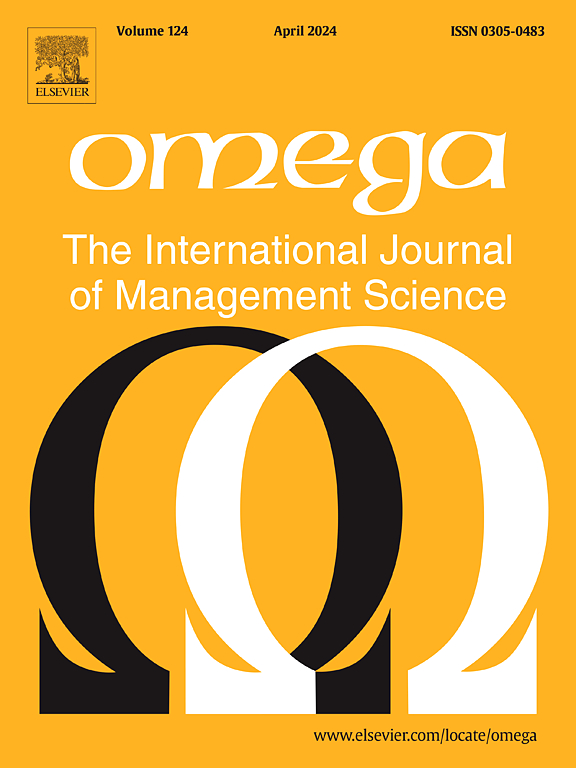对碳边界调整机制的战略回应:何时以及如何实施碳税
IF 7.2
2区 管理学
Q1 MANAGEMENT
Omega-international Journal of Management Science
Pub Date : 2025-06-10
DOI:10.1016/j.omega.2025.103383
引用次数: 0
摘要
本研究探讨了低碳管制国家(LCRC)何时以及如何实施碳税以应对高碳管制国家(HCRC)实施碳边界调整机制(CBAM)。我们特别分析了碳成本扣除和免费配额在这些政策中的作用。使用免费配额作为CBAM政策强度的指标,我们开发了一个模型,代表同时服务于出口(HCRC)和国内市场的LCRC中的制造商。我们的研究结果表明,CBAM强度阈值显著改变了制造商的CBAM成本和决策,产生了两种不同的情景:情景PA(高于阈值的成本)和情景FA(低于阈值的成本)。在情景PA中,尽管国内销售和利润下降,但引入碳税会导致更高的减排水平,增加出口生产,降低总碳排放量。相反,在情景FA中,碳税降低了减排水平和出口产量,增加了碳排放总量。重要的是,我们揭示了碳减排政策强度与最优碳税率之间的动态关系,为LCRC政府应如何随着碳减排强度的增加而调整税率提供了清晰的地图。具体而言,我们建议LCRC政府仅在CBAM政策强度超过阈值时才征收碳税,并逐步提高税率以应对更强的CBAM。此外,碳税收入应战略性地再投资于减排技术,以促进国内制造商的可持续增长。本文章由计算机程序翻译,如有差异,请以英文原文为准。
Strategic responses to the carbon border adjustment mechanism: When and how to implement a carbon tax
This study investigates when and how a low-carbon-regulated country (LCRC) implements a carbon tax in response to the enforcement of a Carbon Border Adjustment Mechanism (CBAM) by a high-carbon regulation country (HCRC). In particular, we analyze the roles of carbon cost deductions and free allowances in such policies. Using free allowances as indicators of CBAM policy intensity, we develop a model representing a manufacturer in an LCRC that serves both export (HCRC) and domestic markets. Our results reveal a CBAM intensity threshold that significantly alters the manufacturer’s CBAM costs and decision-making, yielding two distinct scenarios: Scenario PA (costs incurred above the threshold) and Scenario FA (costs not incurred below the threshold). In Scenario PA, introducing a carbon tax leads to higher emission reduction levels, increased export production, and lower total carbon emissions, despite a decline in domestic sales and profits. Conversely, in Scenario FA, the carbon tax reduces emission reduction levels and export production, increasing total carbon emissions. Importantly, we reveal the dynamic relationship between CBAM policy intensity and optimal carbon tax rates, providing a clear map for how the LCRC government should adjust tax rates as CBAM intensity increases. Specifically, we recommend that the LCRC government adopt a carbon tax only when the CBAM policy intensity exceeds the threshold and progressively increase the tax rate in response to a stronger CBAM. Furthermore, carbon tax revenues should be strategically reinvested in emission reduction technologies to foster sustainable growth for domestic manufacturers.
求助全文
通过发布文献求助,成功后即可免费获取论文全文。
去求助
来源期刊

Omega-international Journal of Management Science
管理科学-运筹学与管理科学
CiteScore
13.80
自引率
11.60%
发文量
130
审稿时长
56 days
期刊介绍:
Omega reports on developments in management, including the latest research results and applications. Original contributions and review articles describe the state of the art in specific fields or functions of management, while there are shorter critical assessments of particular management techniques. Other features of the journal are the "Memoranda" section for short communications and "Feedback", a correspondence column. Omega is both stimulating reading and an important source for practising managers, specialists in management services, operational research workers and management scientists, management consultants, academics, students and research personnel throughout the world. The material published is of high quality and relevance, written in a manner which makes it accessible to all of this wide-ranging readership. Preference will be given to papers with implications to the practice of management. Submissions of purely theoretical papers are discouraged. The review of material for publication in the journal reflects this aim.
 求助内容:
求助内容: 应助结果提醒方式:
应助结果提醒方式:


